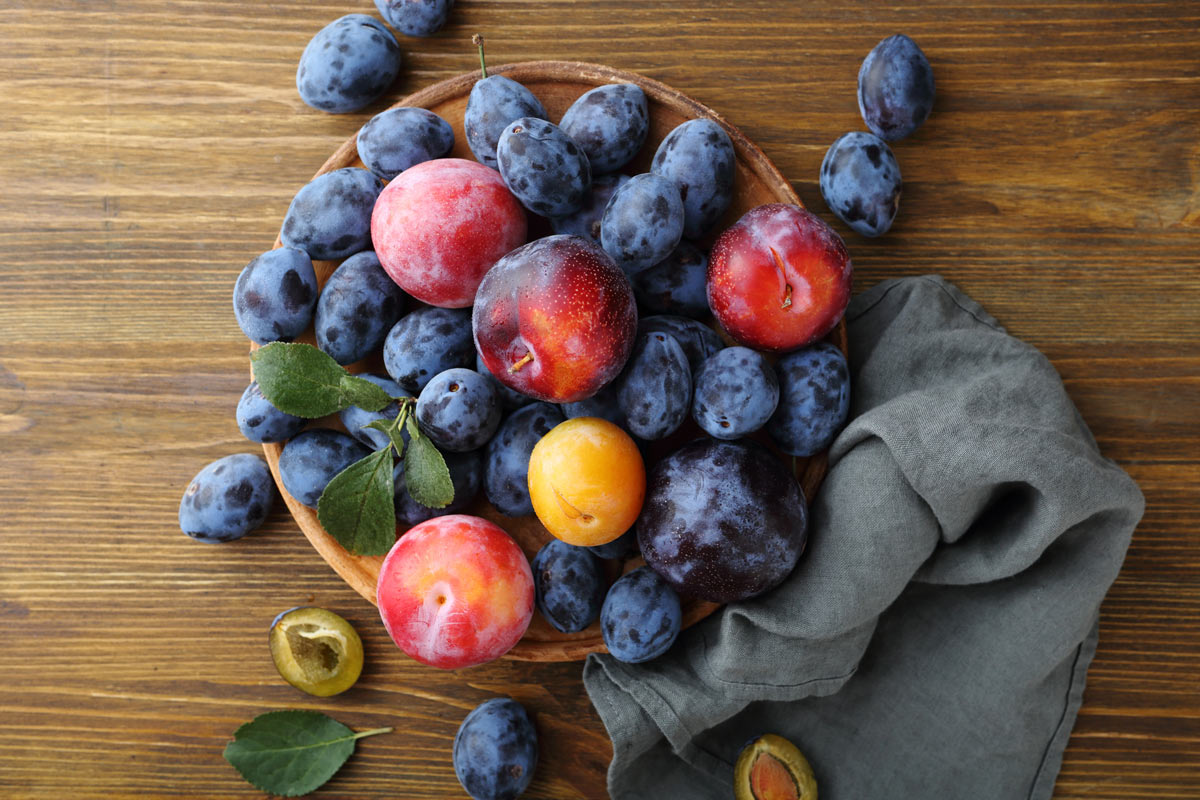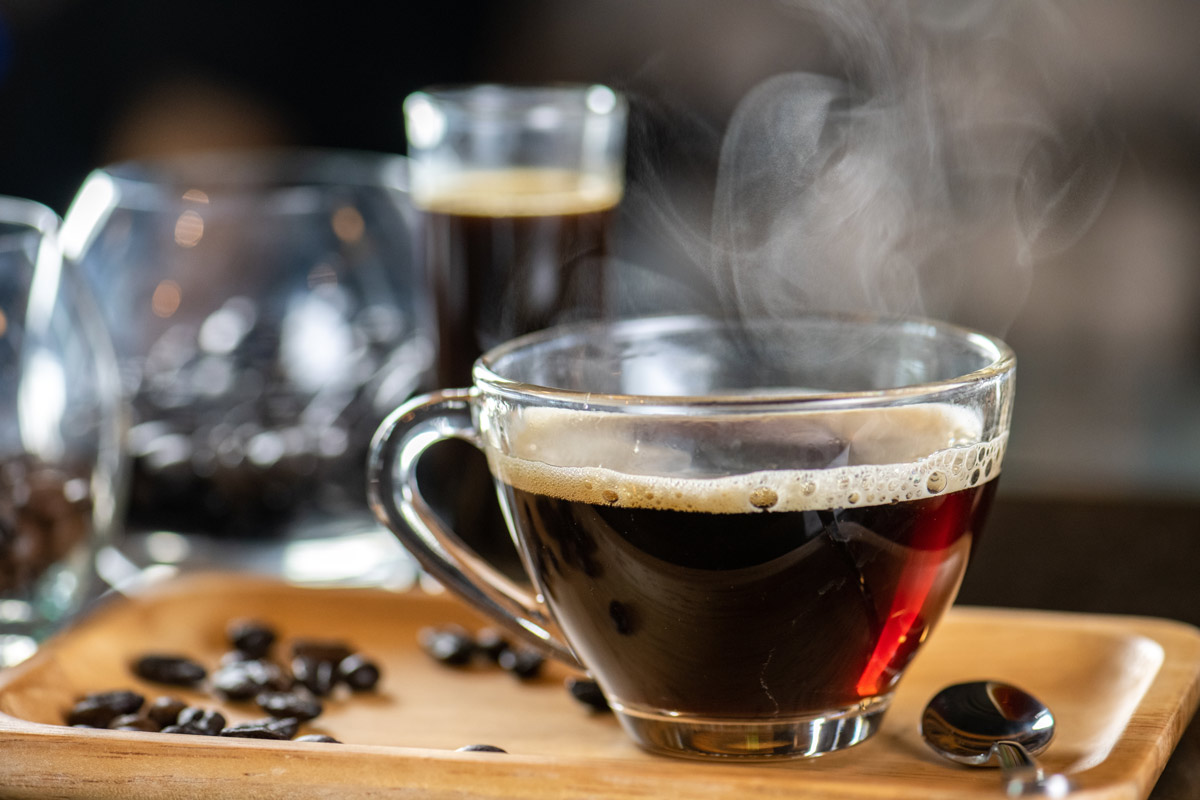Burrata and Stone Fruit Salad Recipe, Spotlight on Plums, Storing Stone Fruit, Is Black Coffee the Secret to a Longer Life, and Matching Workouts to Your Personality
’Tis the season … for stone fruit, that is. Nature’s bounty of plums, apricots, and peaches is at its height in late summer, and a composed salad is a fantastic way to enjoy them—no cooking required! Love your morning joe? I’m sharing new insights into its health benefits and why, in order to reap benefits from exercise, it’s so important to focus on activities you truly enjoy.
Burrata and Stone Fruit Salad
 Burrata and Stone Fruit Salad
Burrata and Stone Fruit SaladThis dish is delicious any time of day—from breakfast to dessert. I love to mix different varieties of the same fruit, such as yellow, red, and purple plums, and white and yellow peaches, but most important is to buy local for the sweetest, freshest fruits.
Ingredients
For the dressing:
- 2 tablespoons extra virgin olive oil
- 2 tablespoons honey, preferably a variety local to your area
- 1 tablespoon balsamic vinegar of Modena
For the salad:
- 2 plums
- 2 peaches
- 4 apricots
- 1/4 lemon
- 1 fresh burrata
- Fresh thyme, oregano, or basil leaves
- Black pepper
Directions
Step 1
Make the dressing by whisking together the oil, honey, and balsamic; set aside.
Step 2
For the salad, halve the fruit, remove the pits (the “stones”), and slice into wedges. Place in a large bowl and squeeze on the juice from the lemon.
Step 3
To compose the salad, cut the burrata in half and center a half on each of two plates. Arrange the fruit around the cheese and drizzle with the dressing. Top with fresh herbs and a few twists of black pepper from your grinder.
Yields 2 servings

Healthy Ingredient Spotlight
Plums
Rich in antioxidants thanks to their high flavonoid content, plums deserve a place on your fruit list, and with dozens of varieties available, you can have fun hunting for the ones you like best. Of course, the deeper the color—which comes from its anthocyanins, a type of flavonoid—the more benefits you’ll reap. Plums are anti-inflammatory, have a respectable amount of fiber, and may even help keep blood sugar levels on an even keel. Eating dried plums, AKA prunes, has been linked to better bone health, too. Just avoid those with added sugar and limit quantities since they’re high in calories.


Quick Kitchen Nugget
Storing Stone Fruit
Peaches, plums, and apricots can be stored at room temperature until ripe. If you’re not yet ready to eat them, move them to the fridge—that buys you a few days, though they may not taste as sweet. An ideal vessel is an empty egg carton (paper, not plastic or foam) because it offers cushioning to avoid bruising and moisture absorption to avoid mold.

For Your Best Health
Is Black Coffee the Secret to a Longer Life?
Coffee might be doing more than fueling your morning routine—it could be extending your life. But here’s the catch: The benefits drop when sugar and saturated fats like cream are added in excess.
In a new observational study, published online in The Journal of Nutrition, researchers from the Gerald J. and Dorothy R. Friedman School of Nutrition Science and Policy at Tufts University found that having one to two cups of caffeinated coffee per day was linked to a lower risk of death from all causes and death from cardiovascular disease, but that the benefits dropped depending on what was added to it.
Black coffee and coffee with low levels of added sugar and saturated fat were associated with a 14% lower risk of all-cause mortality as compared to no coffee consumption. The same link was not observed for coffee with high amounts of added sugar and saturated fat.
“Coffee is among the most-consumed beverages in the world and, with nearly half of American adults reporting drinking at least one cup per day, it’s important for us to know what it might mean for health,” said Fang Fang Zhang, PhD, senior author of the study and the Neely Family Professor at the Friedman School. “The health benefits of coffee might be attributable to its bioactive compounds, but our results suggest that the addition of sugar and saturated fat may reduce the mortality benefits.”

The study analyzed data from nine consecutive cycles of the National Health and Nutrition Examination Survey from 1999 to 2018, linked to National Death Index Mortality Data. The study included a nationally representative sample of 46,000 adults aged 20 years and older who completed valid first-day 24-hour dietary recalls. Coffee consumption was categorized by type (caffeinated or decaffeinated), sugar, and saturated fat content. Mortality outcomes included all-cause, cancer, and cardiovascular disease. Low added sugar (from granulated sugar, honey, and syrup) was defined as under 5% of the Daily Value, which is 2.5 grams per 8-ounce cup or approximately half a teaspoon of sugar. Low saturated fat (from milk, cream, and half-and-half) was defined as 5% of the Daily Value, or 1 gram per 8-ounce cup or the equivalent of 5 tablespoons of 2% milk, 1 tablespoon of light cream, or 1 tablespoon of half-and-half.
In the study, consumption of at least one cup per day was associated with a 16% lower risk of all-cause mortality. At two to three cups per day, the link rose to 17%. Consumption beyond three cups per day was not associated with additional reductions, and the link between coffee and a lower risk of death by cardiovascular disease weakened when coffee consumption was more than three cups per day. No significant associations were seen between coffee consumption and cancer mortality.
“Few studies have examined how coffee additives could impact the link between coffee consumption and mortality risk, and our study is among the first to quantify how much sweetener and saturated fat are being added,” said first author Bingjie Zhou, a recent PhD graduate from the nutrition epidemiology and data science program at the Friedman School. “Our results align with the Dietary Guidelines for Americans, which recommend limiting added sugar and saturated fat.”
Limitations of the study include the fact that self-reported recall data is subject to measurement error due to day-to-day variations in food intake. The lack of significant associations between decaffeinated coffee and all-cause mortality could be due to low consumption among the population studied.

Fitness Flash
Matching Workouts to Your Personality
According to researchers at University College London (UCL), the key to sticking with and reaping the rewards of exercise over the long term, like boosting fitness and slashing stress, may be as simple as doing activities you enjoy and that align with your personality.
Previous research showed that the personalities of people who engage in different types of organized sport tend to vary. But what was less clear was how personality affects the types of exercise people actually enjoy doing. The new study, published in Frontiers in Psychology, explored whether individual personality traits corresponded to the enjoyment of different types of exercise, whether participants completed a prescribed exercise program, and the subsequent impact on their fitness levels.
Flaminia Ronca, PhD, associate professor at the UCL Institute of Sport, Exercise, and Health, and first author of the study, said, “We know that the global population is becoming increasingly sedentary. You often hear about people trying to become more active but struggling to make lasting changes. In this study, we wanted to understand how personality can influence this to support the development of effective interventions for changes in health behavior. We found some clear links between personality traits and the type of exercise the participants enjoyed most, which I think is important because we could potentially use this knowledge to tailor physical activity recommendations to the individual and hopefully help them to become and remain more active.”
For the study, the team assessed 132 volunteers from the general public with a range of fitness levels and backgrounds, who were assigned either to an 8-week cycling and strength training program (the intervention group) or to a resting control group. There were three weekly cycling sessions that varied in intensity: a 60-minute light ride at an easy pace, a 30-minute threshold ride at a moderate but sustainable effort, or high-intensity interval training (HIIT) where the level of exertion varied.
Participants’ benchmark fitness levels were assessed at the beginning of the program. Strength was tested using press-ups, performing a plank to failure, and countermovement jumps (jumping again immediately after landing). This was followed by a low-intensity cycling session for 30 minutes, then a cycling test to measure peak oxygen capacity (V̇O2 max test) after a short rest.
The team also assessed participants’ perceived stress levels on a scale of 1 to 10, as well as their personality traits using the Big 5 model, a common personality test in the field of sport and exercise psychology that groups people according to whether their dominant trait is extroversion, agreeableness, conscientiousness, neuroticism, or openness. During the exercise program, participants were asked to rate their enjoyment of each exercise session.
Their fitness level was tested again once the program had been completed. Of the 132 starters, 86 people completed the intervention and all of these participants got fitter and stronger regardless of personality. While not all personality traits had a link to exercise enjoyment, several connections were uncovered by the study:
- Extroverts tended to particularly enjoy high-intensity exercise, such as HIIT and a fitness test of maximum-intensity cycling.
- Those with a strong neuroticism trait engaged well with the exercise intervention but preferred bursts of intensity rather than prolonged intensity. They also preferred not being monitored, such as not having their heart rate recorded while undertaking the program, suggesting that these individuals might appreciate being given space for independence and privacy when engaging in exercise.
- Those who were conscientious tended to have a well-rounded fitness level, meaning that they tended to score more highly on aerobic fitness as well as core strength, and were generally more physically active. However, conscientiousness didn’t predict higher enjoyment of a specific form of exercise. The authors said this might be because conscientious individuals tend to be driven by the health-related outcomes of engaging in physical activity rather than enjoyment, suggesting that adherence to the program may be less about enjoyment than because it was good for them.
At the beginning of the study, the stress levels of the intervention group and the control group were similar. However, the only group to experience a significant reduction in stress levels after exercising were those who scored highly in the neuroticism trait. “This suggests that there may be particular benefits in stress reduction for those with this trait,” said Professor Paul Burgess, PhD, professor of cognitive neuroscience and an author of the study.
The researchers concluded that the most important thing people can do to improve their activity levels is to find something that they enjoy, which will make it more likely that they’ll stick with it.
Get More Recipes In Your Inbox!








